Panic Buying Behavior Analysis according to Consumer Income and Product Type during COVID-19
Abstract
1. Introduction
2. Literature Review
2.1. PB and Consumer Behavior
2.2. PB and Public Policies
2.3. PB and Income
3. Materials and Methods
3.1. Data Collection, Processing, and Validation
- Meat: comprising chicken (2 types: cooled and frozen) and beef;
- Hygiene and cleansing: comprising bleach, disinfectant, and soap;
- Candies: selected as a baseline or comparison category, due to information from store professionals that no PB was detected in this category.
3.2. Geocoding and Geographic Analysis
3.3. Identifying the Analysis Periods
3.4. Statistical Analysis
4. Data Analysis and Results
4.1. Step I: Regression Analysis between PB Ratio and Average per Capita Income
4.2. Step II: Analysis of Sales Averages in Different Periods
Analysis According to Categories
5. Discussion and Implications
6. Conclusions
Author Contributions
Funding
Institutional Review Board Statement
Informed Consent Statement
Data Availability Statement
Acknowledgments
Conflicts of Interest
References
- Prentice, C.; Chen, J.; Stantic, B. Timed Intervention in COVID-19 and Panic Buying. J. Retail. Consum. Serv. 2020, 57, 102203. [Google Scholar] [CrossRef]
- Ali Taha, V.; Pencarelli, T.; Škerháková, V.; Fedorko, R.; Košíková, M. The Use of Social Media and Its Impact on Shopping Behavior of Slovak and Italian Consumers during COVID-19 Pandemic. Sustainability 2021, 13, 1710. [Google Scholar] [CrossRef]
- Islam, T.; Pitafi, A.H.; Arya, V.; Wang, Y.; Akhtar, N.; Mubarik, S.; Xiaobei, L. Panic Buying in the COVID-19 Pandemic: A Multi-Country Examination. J. Retail. Consum. Serv. 2021, 59, 102357. [Google Scholar] [CrossRef]
- Leung, J.; Chung, J.Y.C.; Tisdale, C.; Chiu, V.; Lim, C.C.W.; Chan, G. Anxiety and Panic Buying Behaviour during COVID-19 Pandemic—A Qualitative Analysis of Toilet Paper Hoarding Contents on Twitter. Int. J. Environ. Res. Public Health 2021, 18, 1127. [Google Scholar] [CrossRef] [PubMed]
- Naeem, M. Do Social Media Platforms Develop Consumer Panic Buying during the Fear of Covid-19 Pandemic. J. Retail. Consum. Serv. 2021, 58, 102226. [Google Scholar] [CrossRef]
- Prentice, C.; Nguyen, M.; Nandy, P.; Aswin Winardi, M.; Chen, Y.; Le Monkhouse, L.; Dominique-Ferreira, S.; Stantic, B. Relevant, or Irrelevant, External Factors in Panic Buying. J. Retail. Consum. Serv. 2021, 61, 102587. [Google Scholar] [CrossRef]
- Valaskova, K.; Durana, P.; Adamko, P. Changes in Consumers’ Purchase Patterns as a Consequence of the COVID-19 Pandemic. Mathematics 2021, 9, 1788. [Google Scholar] [CrossRef]
- Mahajan, V.; Cantelmo, G.; Antoniou, C. Explaining Demand Patterns during COVID-19 Using Opportunistic Data: A Case Study of the City of Munich. Eur. Transp. Res. Rev. 2021, 13, 26. [Google Scholar] [CrossRef]
- He, J.; Liu, S.; Li, T.; Mai, T.H.T. The Positive Effects of Unneeded Consumption Behaviour on Consumers during the COVID-19 Pandemic. Int. J. Environ. Res. Public Health 2021, 18, 6404. [Google Scholar] [CrossRef]
- Giudice, F.; Caferra, R.; Morone, P. COVID-19, the Food System and the Circular Economy: Challenges and Opportunities. Sustainability 2020, 12, 7939. [Google Scholar] [CrossRef]
- Yap, S.; Xu, Y.; Tan, L. Coping with Crisis: The Paradox of Technology and Consumer Vulnerability. Int. J. Consum. Stud. 2021, 45, 1239–1257. [Google Scholar] [CrossRef]
- Yoshizaki, H.T.Y.; de Brito Junior, I.; Hino, C.M.; Aguiar, L.L.; Pinheiro, M.C.R. Relationship between Panic Buying and Per Capita Income during COVID-19. Sustainability 2020, 12, 9968. [Google Scholar] [CrossRef]
- Taylor, S. Understanding and Managing Pandemic-Related Panic Buying. J. Anxiety Disord. 2021, 78, 102364. [Google Scholar] [CrossRef] [PubMed]
- Prentice, C.; Quach, S.; Thaichon, P. Antecedents and Consequences of Panic Buying: The Case of COVID-19. Int. J. Consum. Stud. 2021, 46, 132–146. [Google Scholar] [CrossRef]
- Yuen, K.F.; Wang, X.; Ma, F.; Li, K.X. The Psychological Causes of Panic Buying Following a Health Crisis. Int. J. Environ. Res. Public Health 2020, 17, 3513. [Google Scholar] [CrossRef] [PubMed]
- Kursan Milaković, I. Purchase Experience during the COVID-19 Pandemic and Social Cognitive Theory: The Relevance of Consumer Vulnerability, Resilience, and Adaptability for Purchase Satisfaction and Repurchase. Int. J. Consum. Stud. 2021, 45, 1425–1442. [Google Scholar] [CrossRef]
- Baker, E.J. Household Preparedness for the Aftermath of Hurricanes in Florida. Appl. Geogr. 2011, 31, 46–52. [Google Scholar] [CrossRef]
- Keane, M.; Neal, T. Consumer Panic in the COVID-19 Pandemic. J. Econom. 2021, 220, 86–105. [Google Scholar] [CrossRef]
- Shanthakumar, S.G.; Seetharam, A.; Ramesh, A. Understanding the Socio-Economic Disruption in the United States during COVID-19’s Early Days. Available online: http://arxiv.org/abs/2004.05451 (accessed on 11 April 2020).
- Brugarolas, M.; Martínez-Carrasco, L.; Rabadán, A.; Bernabéu, R. Innovation Strategies of the Spanish Agri-Food Sector in Response to the Black Swan COVID-19 Pandemic. Foods 2020, 9, 1821. [Google Scholar] [CrossRef]
- Billore, S.; Anisimova, T. Panic Buying Research: A Systematic Literature Review and Future Research Agenda. Int. J. Consum. Stud. 2021, 45, 777–804. [Google Scholar] [CrossRef]
- Chua, G.; Yuen, K.F.; Wang, X.; Wong, Y.D. The Determinants of Panic Buying during COVID-19. Int. J. Environ. Res. Public Health 2021, 18, 3247. [Google Scholar] [CrossRef] [PubMed]
- Dulam, R.; Furuta, K.; Kanno, T. Consumer Panic Buying: Realizing Its Consequences and Repercussions on the Supply Chain. Sustainability 2021, 13, 4370. [Google Scholar] [CrossRef]
- Kaur, A.; Malik, G. Understanding the Psychology Behind Panic Buying: A Grounded Theory Approach. Glob. Bus. Rev. 2020, 1–14. [Google Scholar] [CrossRef]
- Li, X.; Zhou, Y.; Wong, Y.D.; Wang, X.; Yuen, K.F. What Influences Panic Buying Behaviour? A Model Based on Dual-System Theory and Stimulus-Organism-Response Framework. Int. J. Disaster Risk Reduct. 2021, 64, 102484. [Google Scholar] [CrossRef]
- Arafat, S.M.Y.; Kar, S.K.; Marthoenis, M.; Sharma, P.; Hoque Apu, E.; Kabir, R. Psychological Underpinning of Panic Buying during Pandemic (COVID-19). Psychiatry Res. 2020, 289, 113061. [Google Scholar] [CrossRef]
- Roșu, M.-M.; Ianole-Călin, R.; Dinescu, R.; Bratu, A.; Papuc, R.-M.; Cosma, A. Understanding Consumer Stockpiling during the COVID-19 Outbreak through the Theory of Planned Behavior. Mathematics 2021, 9, 1950. [Google Scholar] [CrossRef]
- Lehberger, M.; Kleih, A.-K.; Sparke, K. Panic Buying in Times of Coronavirus (COVID-19): Extending the Theory of Planned Behavior to Understand the Stockpiling of Nonperishable Food in Germany. Appetite 2021, 161, 105118. [Google Scholar] [CrossRef]
- Wilk, V.; Mat Roni, S.; Jie, F. Supply Chain Insights from Social Media Users’ Responses to Panic Buying during COVID-19: The Herd Mentality. Asia Pac. J. Mark. Logist. 2022. [Google Scholar] [CrossRef]
- Arafat, S.M.Y.; Kar, S.K.; Menon, V.; Alradie-Mohamed, A.; Mukherjee, S.; Kaliamoorthy, C.; Kabir, R. Responsible Factors of Panic Buying: An Observation From Online Media Reports. Front. Public Health 2020, 8, 4–9. [Google Scholar] [CrossRef]
- Arafat, S.M.Y.; Ahmad, A.R.; Murad, H.R.; Kakashekh, H.M. Perceived Impact of Social Media on Panic Buying: An Online Cross-Sectional Survey in Iraqi Kurdistan. Front. Public Health 2021, 9, 668153. [Google Scholar] [CrossRef]
- Jin, X.; Li, J.; Song, W.; Zhao, T. The Impact of COVID-19 and Public Health Emergencies on Consumer Purchase of Scarce Products in China. Front. Public Health 2020, 8, 617166. [Google Scholar] [CrossRef] [PubMed]
- Garbe, L.; Rau, R.; Toppe, T. Influence of Perceived Threat of Covid-19 and HEXACO Personality Traits on Toilet Paper Stockpiling. PLoS ONE 2020, 15, e0234232. [Google Scholar] [CrossRef] [PubMed]
- Ahmed, R.R.; Streimikiene, D.; Rolle, J.-A.; Duc, P.A. The COVID-19 Pandemic and the Antecedants for the Impulse Buying Behavior of US Citizens. J. Compet. 2020, 12, 5–27. [Google Scholar] [CrossRef]
- Micalizzi, L.; Zambrotta, N.S.; Bernstein, M.H. Stockpiling in the Time of COVID-19. Br. J. Health Psychol. 2020, 26, 535–543. [Google Scholar] [CrossRef]
- Wang, E.; An, N.; Gao, Z.; Kiprop, E.; Geng, X. Consumer Food Stockpiling Behavior and Willingness to Pay for Food Reserves in COVID-19. Food Secur. 2020, 12, 739–747. [Google Scholar] [CrossRef] [PubMed]
- Wang, H.H.; Hao, N. Panic Buying? Food Hoarding during the Pandemic Period with City Lockdown. J. Integr. Agric. 2020, 19, 2916–2925. [Google Scholar] [CrossRef]
- Singh, G.; Aiyub, A.S.; Greig, T.; Naidu, S.; Sewak, A.; Sharma, S. Exploring Panic Buying Behavior during the COVID-19 Pandemic: A Developing Country Perspective. Int. J. Emerg. Mark. 2021; ahead-of-print. [Google Scholar] [CrossRef]
- Chen, T.; Jin, Y.; Yang, J.; Cong, G. Emergence Model of Group Panic Buying Behavior under the COVID-19 Pandemic. J. Retail. Consum. Serv. 2022, 67, 102970. [Google Scholar] [CrossRef]
- Grashuis, J.; Skevas, T.; Segovia, M.S. Grocery Shopping Preferences during the COVID-19 Pandemic. Sustainability 2020, 12, 5369. [Google Scholar] [CrossRef]
- Preoţiuc-Pietro, D.; Volkova, S.; Lampos, V.; Bachrach, Y.; Aletras, N. Studying User Income through Language, Behaviour and Affect in Social Media. PLoS ONE 2015, 10, e0138717. [Google Scholar] [CrossRef]
- Ismail, O.; Sharnoubi, O. El Corona Panic Buyers Are Mostly Rich People, Grocers Say. Available online: https://www.madamasr.com/en/2020/03/22/feature/society/corona-panic-buyers-are-mostly-rich-people-grocers-say/ (accessed on 29 October 2020).
- Warren, K. Grocery Stores in the Richest and Poorest Parts of NYC Are Struggling, but for Very Different Reasons. It’s yet Another Sign of How Diferently the Wealthy Are Weathering the Pandemic. Available online: https://www.businessinsider.com/nyc-grocery-stores-struggling-wealth-flight-jobs-cut-2020-4 (accessed on 29 October 2020).
- O’Connell, M.; de Paula, Á.; Smith, K. Preparing for a Pandemic: Spending Dynamics and Panic Buying during the COVID-19 First Wave. Fisc. Stud. 2021, 42, 249–264. [Google Scholar] [CrossRef]
- Abras. Abras Essencial. 2020, p. 116. Available online: https://superhiper.abras.com.br/pdf/259.pdf (accessed on 21 February 2022).
- Sorensen, H.; Bogomolova, S.; Anderson, K.; Trinh, G.; Sharp, A.; Kennedy, R.; Page, B.; Wright, M. Fundamental Patterns of In-Store Shopper Behavior. J. Retail. Consum. Serv. 2017, 37, 182–194. [Google Scholar] [CrossRef]
- Sphere Association. The Sphere Handbook: Humanitarian Charter and Minimum Standards in Humanitarian Response, 4th ed.; Sphere Association: Geneva, Switzerland, 2018; Volume 1, ISBN 9781908176707. [Google Scholar]
- IBGE. IBGE Pop e Domicilios Censo 2010. Available online: http://www.ibge.gov.br/home/estatistica/populacao/censo2010/default_resultados_universo.shtm (accessed on 1 December 2011).
- SEADE. Fundação Sistema Estadual de Análise de Dados São Paulo Diversa: Uma Análise a Partir de Regiões Da Cidade. Available online: https://www.seade.gov.br/wp-content/uploads/2020/01/Pesquisa-SEADE_Aniversario-SP_23jan2020.pdf (accessed on 17 October 2020).
- Parente, J.; Kato, H.T. Área de Influência: Um Estudo No Varejo de Supermercados. Rev. Adm. Empres. 2001, 41, 46–53. [Google Scholar] [CrossRef]
- Parente, J.; Kato, H.T. Um Estudo Dos Supermercados No Brasil: Uma Investigação Sobre a Área de Influência. In Proceedings of the XXVII Encontro da ANPAD; Associação Nacional de Pós Graduação e Pesquisa em Administração: Atibaia, Brazil, 2003; pp. 1–17. [Google Scholar]
- SEADE. Fundação Sistema Estadual de Análise de Dados Dados COVID-19 Municípios. Available online: https://www.seade.gov.br/wp-content/uploads/coronavirus-files/Dados-covid-19-municipios.csv (accessed on 17 November 2022).
- Fávero, L.P.; Belfiore, P. Manual de Análise de Dados, 1st ed.; Elsevier: Rio de Janeiro, Brazil, 2017; ISBN 978-85-352-7087-7. [Google Scholar]
- Hair, J.F.; Black, W.C.; Babin, B.J.; Anderson, R.E.; Tatham, R.L. Análise Multivariada de Dados, 6th ed.; Bookman: Porto Alegre, Brazil, 2009; ISBN 9788577805341. [Google Scholar]
- Gordon, B.R.; Goldfarb, A.; Li, Y. Does Price Elasticity Vary with Economic Growth? A Cross-Category Analysis. J. Mark. Res. 2013, 50, 4–23. [Google Scholar] [CrossRef]
- Hunter, L.; Gerritsen, S.; Egli, V. Changes in Eating Behaviours Due to Crises, Disasters and Pandemics: A Scoping Review. Nutr. Food Sci. 2022; ahead-of-print. [Google Scholar] [CrossRef]
- Hirvonen, K.; Brauw, A.; Abate, G.T. Food Consumption and Food Security during the COVID-19 Pandemic in Addis Ababa. Am. J. Agric. Econ. 2021, 103, 772–789. [Google Scholar] [CrossRef] [PubMed]
- Zboraj, M. How the Pandemic Has Affected Eating Habits Acosta Report Details Changes in Consumer Dining, Offers Insight into Post-Pandemic Eating Trends Also Worth Reading Pandemic Category Sales Poised to Outlast Pandemic. Available online: https://progressivegrocer.com/how-pandemic-has-affected-eating-habits (accessed on 21 February 2022).
- Brandtner, P.; Darbanian, F.; Falatouri, T.; Udokwu, C. Impact of COVID-19 on the Customer End of Retail Supply Chains: A Big Data Analysis of Consumer Satisfaction. Sustainability 2021, 13, 1464. [Google Scholar] [CrossRef]
- Holguín-Veras, J.; Encarnación, T.; Van Wassenhove, L.N.; Pokharel, S.; Cantillo, V.; Amaya, J.; Wachtendorf, T.; Rilling, J. Reducing Material Convergence in Disaster Environments: The Potential of Trusted Change Agents. Transp. Res. Part E Logist. Transp. Rev. 2022, 162, 102736. [Google Scholar] [CrossRef]
- Kahneman, D. Thinking, Fast and Slow; Farrar, Straus and Giroux: New York, NY, USA, 2013; ISBN 9780374275631. [Google Scholar]
- Gupta, S.; Gentry, J.W. ‘Should I Buy, Hoard, or Hide?’—Consumers’ Responses to Perceived Scarcity. Int. Rev. Retail. Distrib. Consum. Res. 2019, 29, 178–197. [Google Scholar] [CrossRef]
- Lee, H.L.; Padmanabhan, V.; Whang, S. Information Distortion in a Supply Chain: The Bullwhip Effect. Manag. Sci. 2004, 50, 1875–1886. [Google Scholar] [CrossRef]
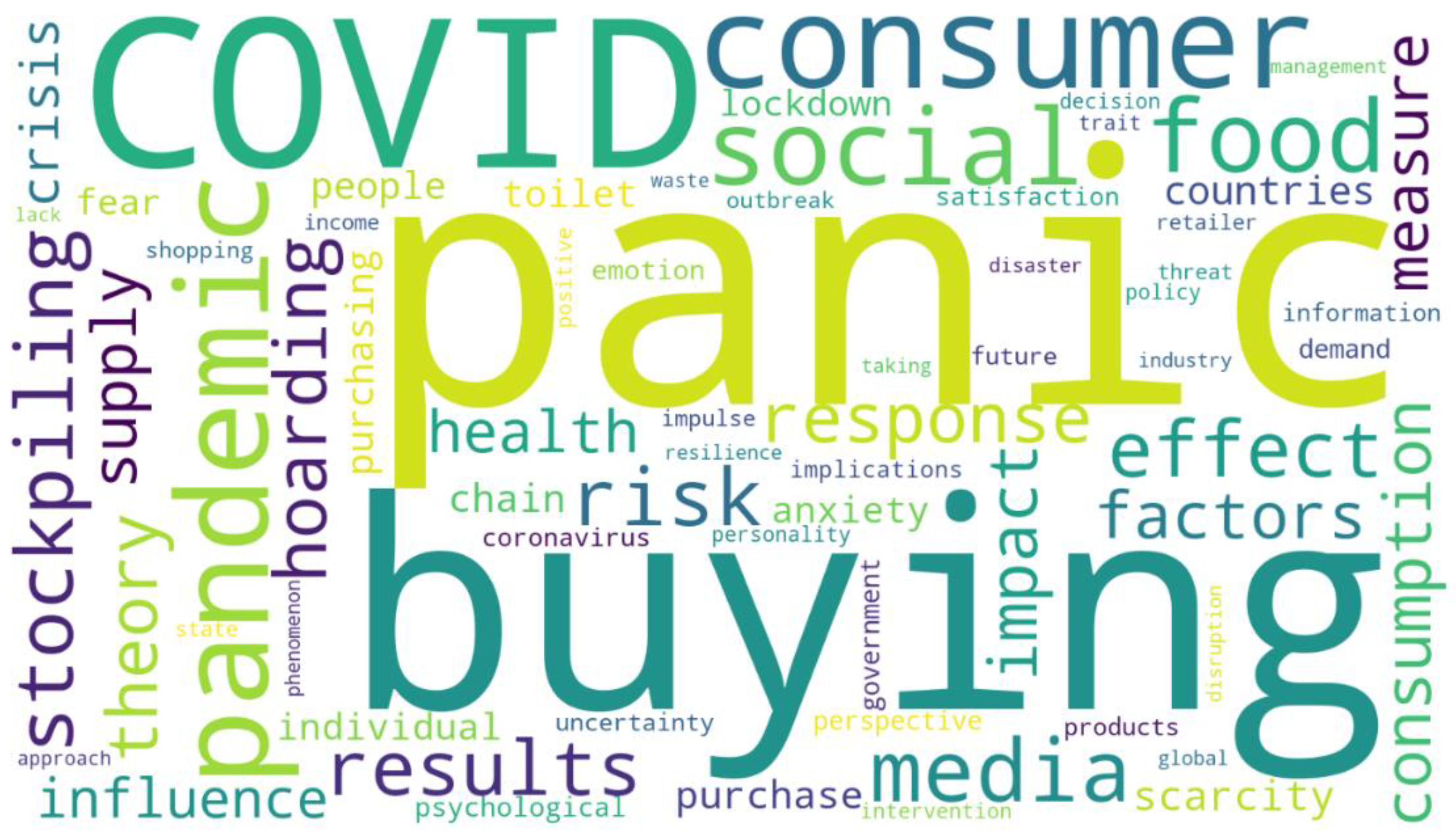
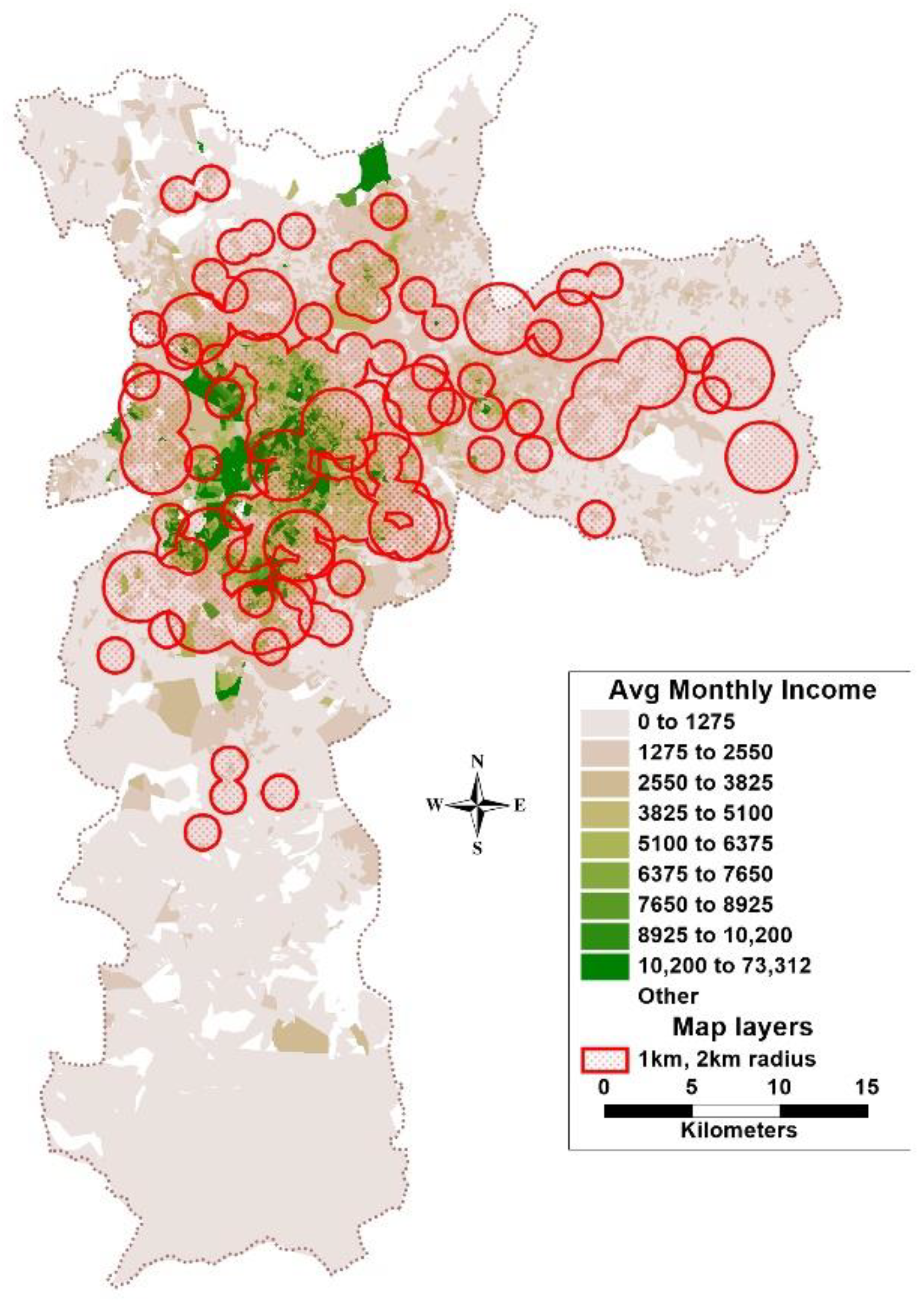
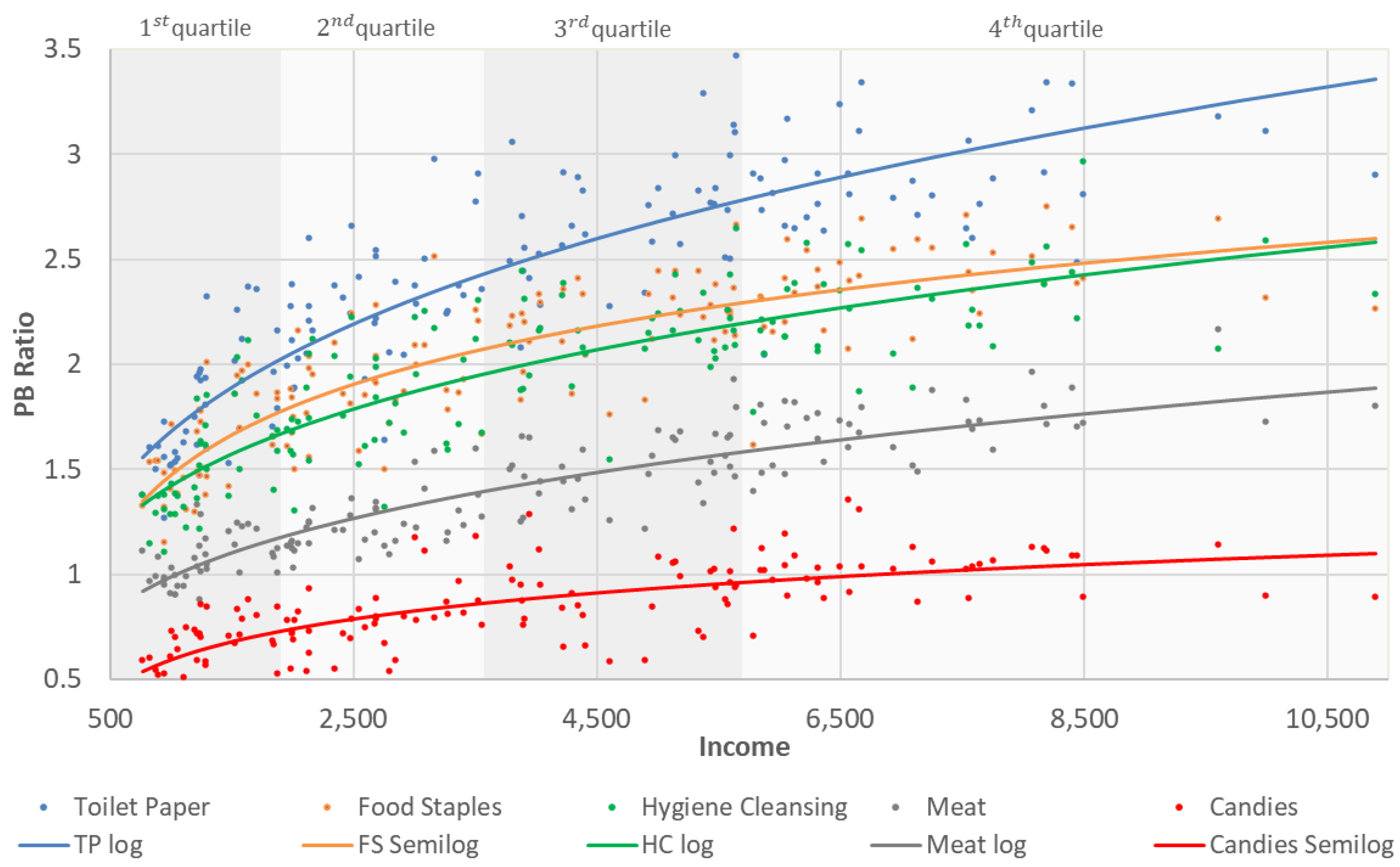
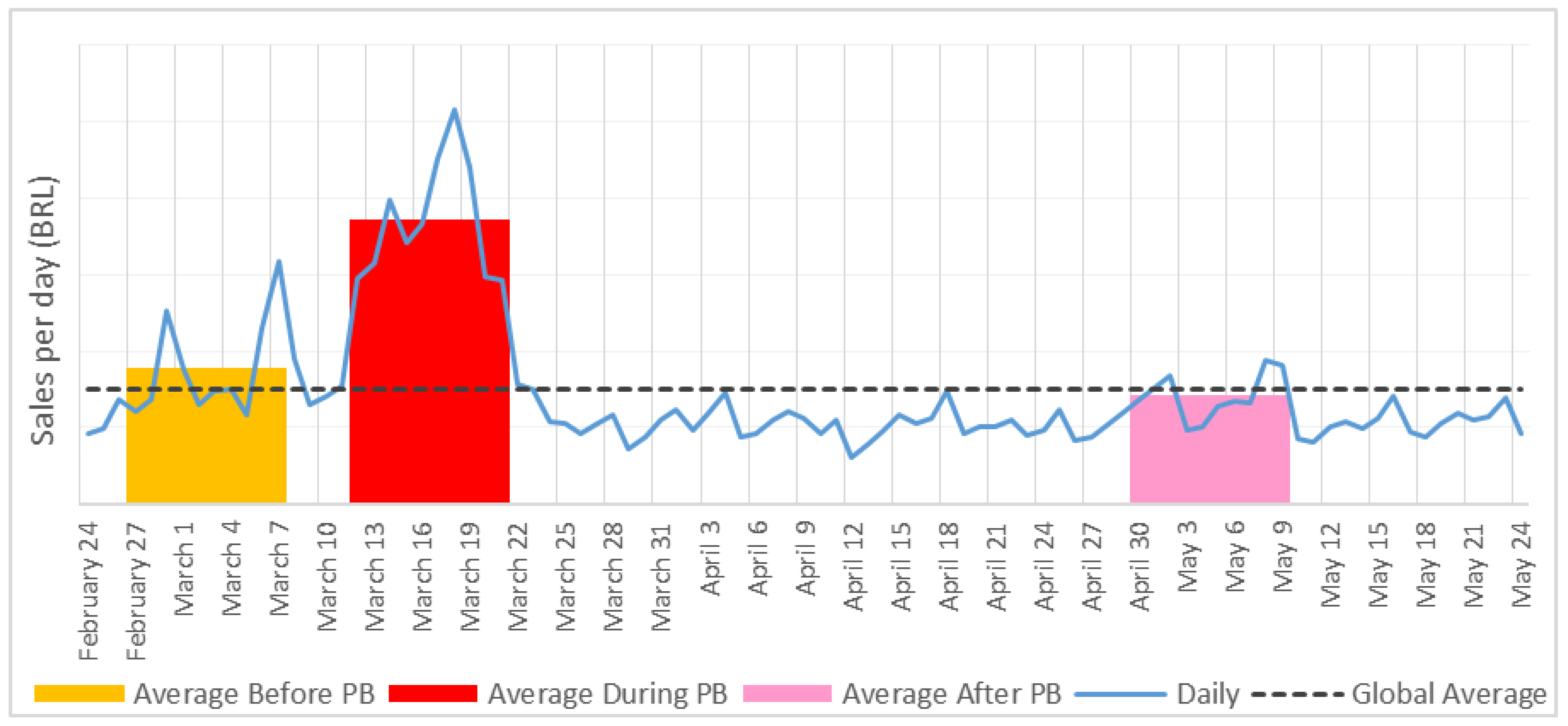
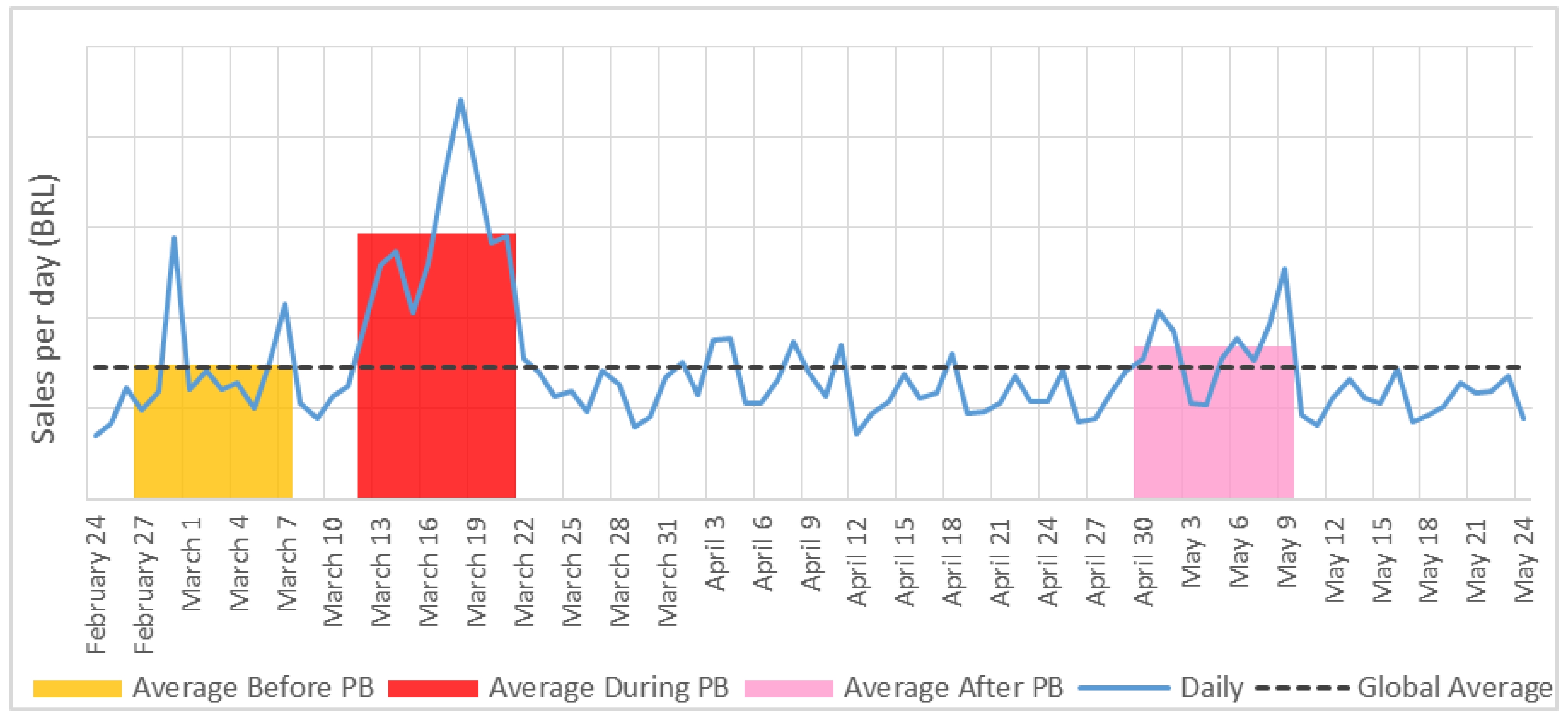

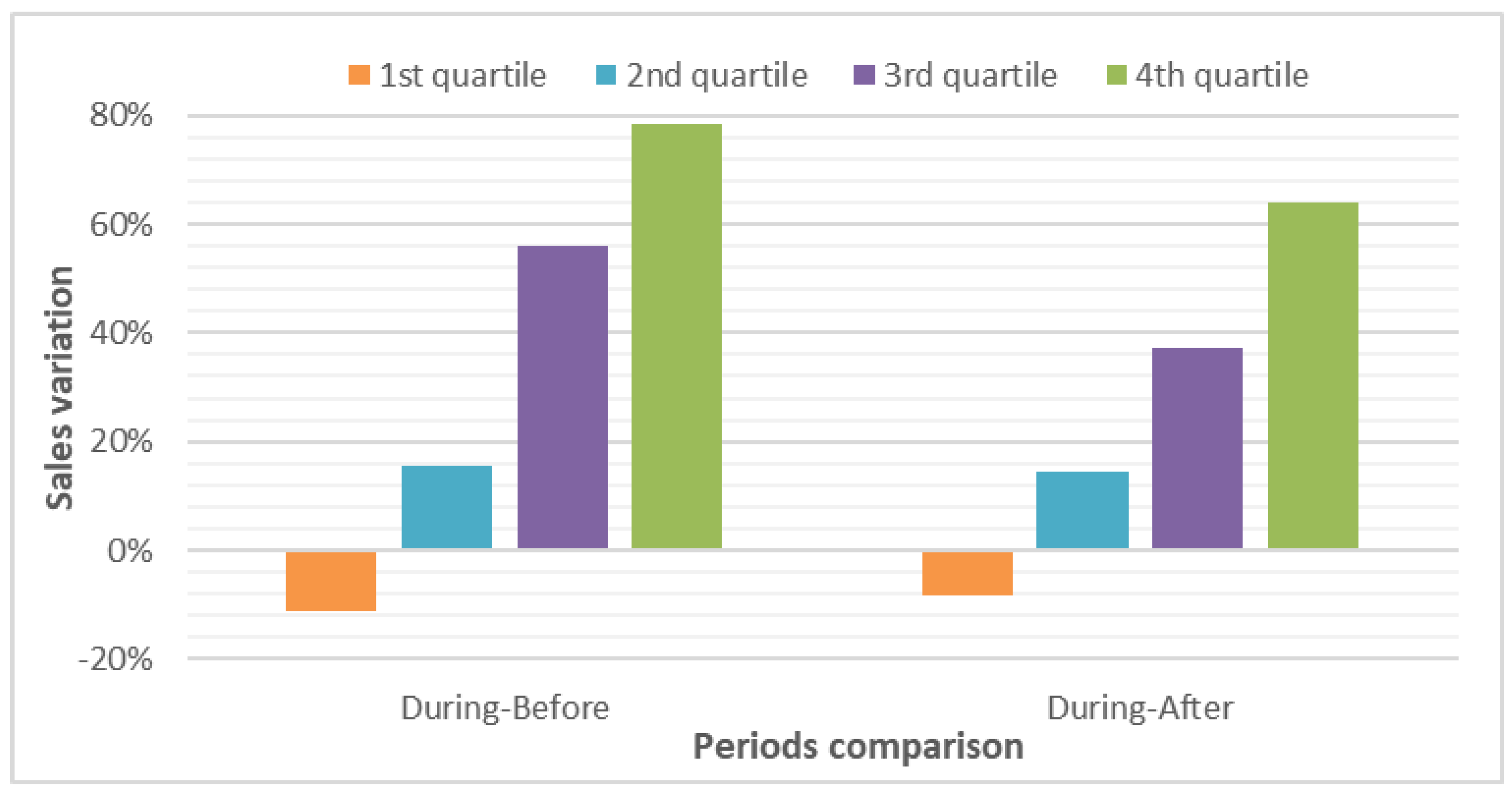
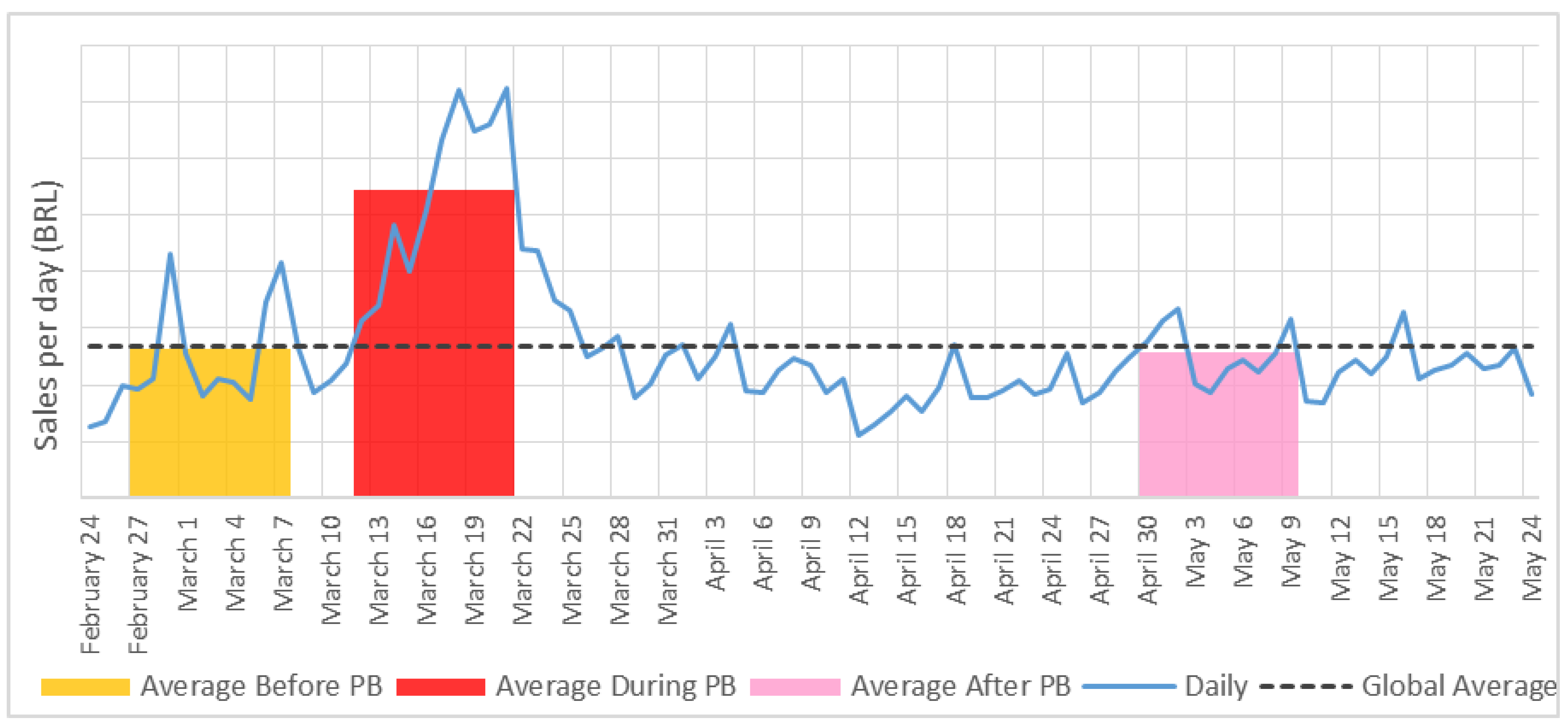
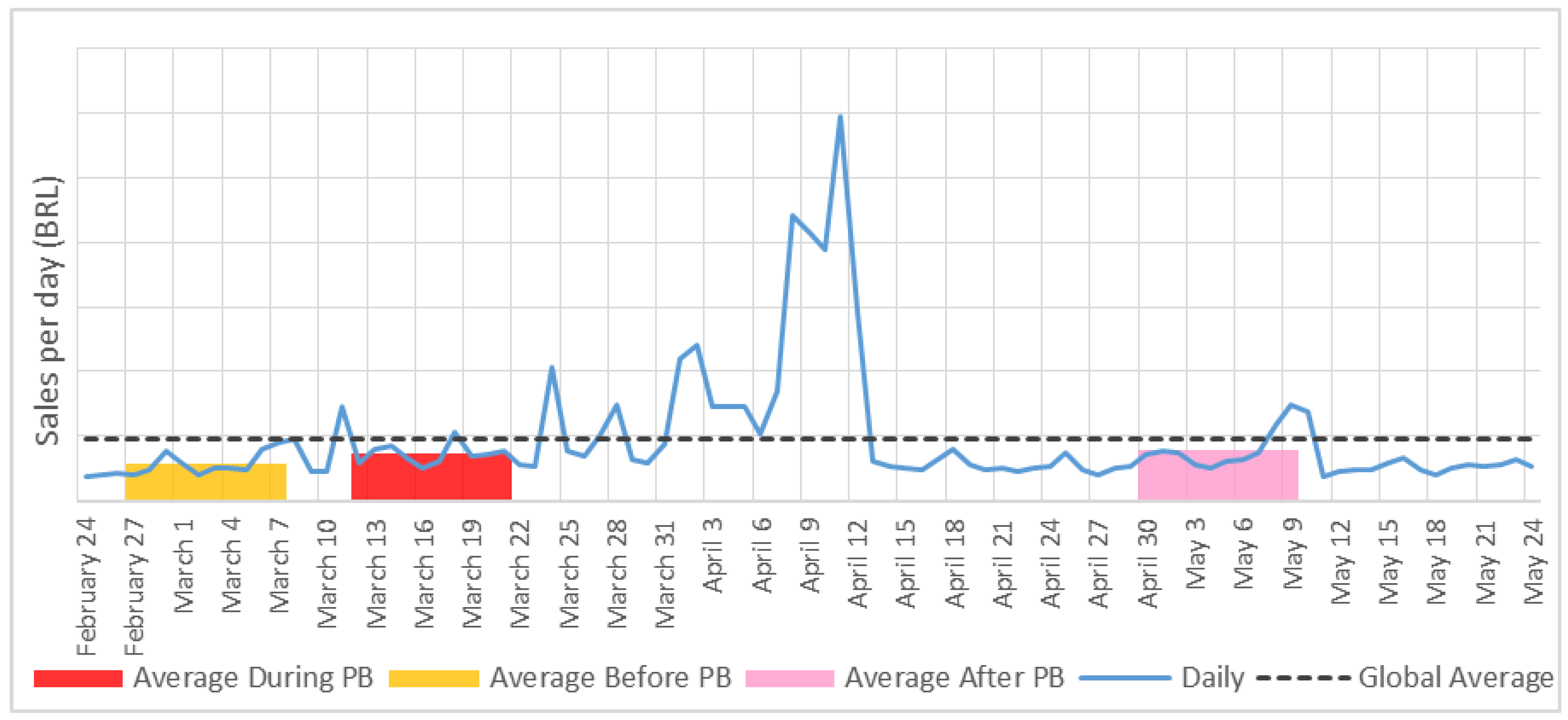
| Quartile | Income Range (BRL) | Income Range (USD) |
|---|---|---|
| 1 | 770–1876 | 435–1066 |
| 2 | 1958–3521 | 1113–2001 |
| 3 | 3555–5643 | 2020–3207 |
| 4 | 5785–10,889 | 3287–6178 |
| Category | Best Fit | r2 | p-Value | Normality | Homoscedasticity |
|---|---|---|---|---|---|
| Toilet paper | Log | 0.7727 | *** | Accept | Accept |
| Food staples | Semilog | 0.7181 | *** | Accept | Accept |
| Meat | Log | 0.8075 | *** | Accept | Accept |
| Hygiene and cleansing | Log | 0.6860 | *** | Accept | Accept |
| Candies | Semilog | 0.4919 | *** | Reject | Accept |
| Category | Chi2 | p-Value (prob > Chi2) |
|---|---|---|
| Toilet Paper | 45.12 | *** |
| Food Staples | 8.16 | * |
| Meat | 5.67 | 0.129 |
| Hygiene and cleansing | 4.40 | 0.221 |
| Candies | 6.41 | 0.093 |
| Category | Chi2 | p-Value (prob > Chi2) |
|---|---|---|
| Toilet Paper | 78.12 | *** |
| Food Staples | 60.63 | *** |
| Meat | 75.34 | *** |
| Hygiene and cleansing | 78.10 | *** |
| Candies | 3.85 | 0.278 |
| Category | Chi2 | p-Value (prob > Chi2) |
|---|---|---|
| Toilet Paper | 60.73 | *** |
| Food Staples | 88.53 | *** |
| Meat | 81.58 | *** |
| Hygiene and cleansing | 80.25 | *** |
| Candies | 1.48 | 0.687 |
Disclaimer/Publisher’s Note: The statements, opinions and data contained in all publications are solely those of the individual author(s) and contributor(s) and not of MDPI and/or the editor(s). MDPI and/or the editor(s) disclaim responsibility for any injury to people or property resulting from any ideas, methods, instructions or products referred to in the content. |
© 2023 by the authors. Licensee MDPI, Basel, Switzerland. This article is an open access article distributed under the terms and conditions of the Creative Commons Attribution (CC BY) license (https://creativecommons.org/licenses/by/4.0/).
Share and Cite
de Brito Junior, I.; Yoshizaki, H.T.Y.; Saraiva, F.A.; Bruno, N.d.C.; da Silva, R.F.; Hino, C.M.; Aguiar, L.L.; Ataide, I.M.F.d. Panic Buying Behavior Analysis according to Consumer Income and Product Type during COVID-19. Sustainability 2023, 15, 1228. https://doi.org/10.3390/su15021228
de Brito Junior I, Yoshizaki HTY, Saraiva FA, Bruno NdC, da Silva RF, Hino CM, Aguiar LL, Ataide IMFd. Panic Buying Behavior Analysis according to Consumer Income and Product Type during COVID-19. Sustainability. 2023; 15(2):1228. https://doi.org/10.3390/su15021228
Chicago/Turabian Stylede Brito Junior, Irineu, Hugo Tsugunobu Yoshida Yoshizaki, Flaviane Azevedo Saraiva, Nathan de Campos Bruno, Roberto Fray da Silva, Celso Mitsuo Hino, Larissa Limongi Aguiar, and Isabella Marrey Ferreira de Ataide. 2023. "Panic Buying Behavior Analysis according to Consumer Income and Product Type during COVID-19" Sustainability 15, no. 2: 1228. https://doi.org/10.3390/su15021228
APA Stylede Brito Junior, I., Yoshizaki, H. T. Y., Saraiva, F. A., Bruno, N. d. C., da Silva, R. F., Hino, C. M., Aguiar, L. L., & Ataide, I. M. F. d. (2023). Panic Buying Behavior Analysis according to Consumer Income and Product Type during COVID-19. Sustainability, 15(2), 1228. https://doi.org/10.3390/su15021228







